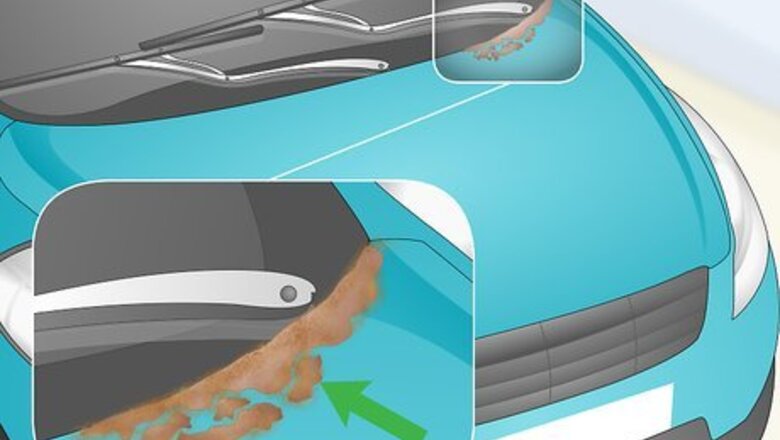
views
Prepping the Car

Identify areas of surface and scale rust on the vehicle. Rust is usually placed into one of three categories based on how serious it is, but penetrating rust is the worst. Check the rust spot for signs that it has created holes through the metal or that the metal has rusted all the way through. If it has, that metal can’t be fixed; it must be replaced. Surface rust is light, and is the first sign of rusting. It is surface deep and usually forms in scratches or nicks in your paint. It will just look like a bit of rust on the metal. Scale rust is more serious, and it develops after surface rust is allowed to spread. It’s the most serious rust you can address easily at home. It may include some paint bubbling or flaking of rusty metal. Penetrating rust develops after rust goes untreated for a long time. If there are holes in the metal or the rust goes all the way through, the only way to fix it is to cut the affected metal out and weld a new piece in its place.

Find the paint code for your vehicle. You will need to repaint the part of your car you remove the rust from, and that means needing to find an exact match for your vehicle’s paint color. Most cars have labels on the body inside the driver’s side door frame and occasionally under the hood that will list that “paint code” used by the manufacturer. Give that code to the clerk at the auto parts store to get a can of paint that matches it exactly. If you can’t find the paint code on the body of the vehicle, you can often find it on the manufacturer’s website or occasionally in the owner’s manual.

Purchase primer, base paint, and clear coat from the auto parts store. You’ll need an automotive primer and paint matched to the vehicle’s color by using the paint code. You will also need a can of automotive clear coat. You can get these paints in spray cans, though you can also get it for use in paint guns with air compressors if you have one. For most minor rust spots, spray cans of paint are sufficient, but if you need to repaint an entire door, hood, or trunk lid, you may want to use an air compressor or secure the help of a bodywork technician.

Wash the area around the rust spot. Use car wash soap, water, and a sponge to scrub any dirt or debris away from the area the rust is to make sure you are able to clearly define what needs to be repaired. When you’re done, rinse the area with clean water. You may want to wash the entire vehicle to look for any other rust spots while you’re at it. Be careful scrubbing the rusty area, as metal flakes may poke into you as the rust comes up.

Tape off the body panel with the rust on it. You’re going to be sanding and painting the area with the rust, so you’ll need to cover anything you don’t want covered in sand and then sprayed with paint. Use painter’s tape to cover headlights, tail lights, windows, or anything else near the rust spot that you don’t want to repaint. Painter’s tape will come back off of the car without leaving any adhesive residue. To tape off large things like a windshield, you can use plastic (like garbage bags) that you secure in place with painter’s tape.
Sanding Away the Rust

Scrape away blistered paint and rust chunks. Use a metal or plastic scraper and wear gloves to ensure none of the sharper chunks can stab or cut you. Removing as much of the loose rust and paint as you can will make sanding much easier. Just press the scraper into the rust repeatedly to free up any loose bits. You can purchase metal or plastic paint scrapers from most hardware stores. Keep scraping until all the loose material is off of the rust spot.
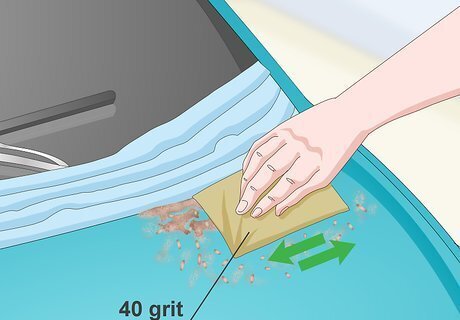
Use 40-grit sandpaper to remove most of the rust. Because 40-grit sandpaper is so rough, it should make short work of most surface and even scale rust. Press the sandpaper flat against the rust spot and move it quickly from side to side, then shift the part of the sandpaper you’re using as that area gets worn out. It may take a few sheets of sandpaper to get all the serious rust off. Keep sanding until you see bare metal.
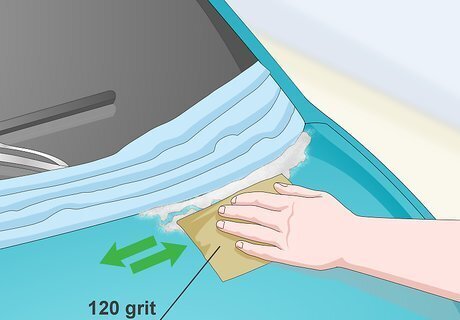
Use 120-grit sandpaper to “feather” the edges of the spot. With the rust sanded away, switch to a finer sandpaper to expand the area you’ve sanded and remove any edge that has developed in the paint. Make sure the metal feels flat, and that there’s no distinct transition between the painted portion of the metal and the bare metal you just removed rust from. Try sanding in small circles along the edge that developed while sanding with the 40-grit sandpaper to create a flat, even surface. You may want to use 220-grit sandpaper after the 120-grit to achieve an even better finish.

Treat the area with rust inhibitor. Even with the rust sanded away, it’s still best to apply a liquid rust inhibitor to it to make sure no new rust is able to develop. Spray the rust inhibitor on and either let it dry or wipe it away, depending on what the specific brand’s instructions tell you. Some rust inhibitors may also come as a gel, which you wipe on and then wipe away. Make sure the surface is completely dry before moving on to the next step.
Applying the Primer
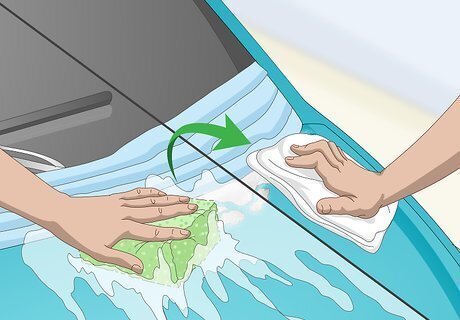
Wash and dry the area again. Thanks to all the sanding, scraping, and spraying you’ve been doing, chances are good that there’s a lot of loose debris on the area you’ll need to paint, so wipe it down with soapy water, rinse it off, and let it dry. Make sure the entire area is completely clean and dry before moving ahead. You can use towels to help speed up the drying process.
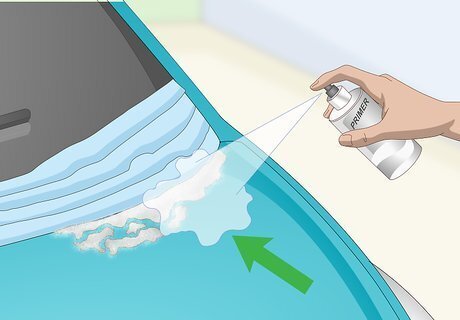
Apply automotive primer evenly to the entire area you’re painting. Hold the spray can (or gun if you’re using one) about 12 inches (30 cm) away from the metal and spray in a steady left to right direction. If the spot is big enough to need you to make multiple passes, overlap each swipe by about 50% to ensure even coverage. Do not hold the paint can or gun in one place while it’s spraying or it will become too thick and begin to drip. Shake the can periodically between sprays to keep the paint distribution even.
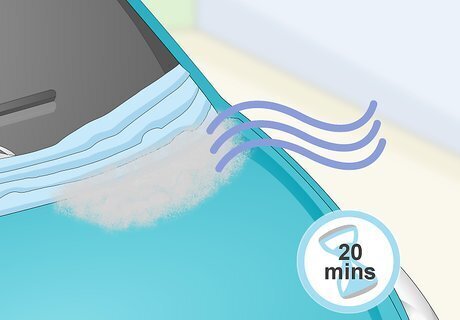
Wait at least 20 minutes for the primer to dry. Depending on how large an area you’re painting, you may choose to apply a second coat of primer, but for most small jobs it isn’t necessary. Read the instructions on the primer to know how long it needs to dry, but 20 minutes is usually sufficient. In unusually humid climates it may take longer than 20 minutes for the primer to dry.
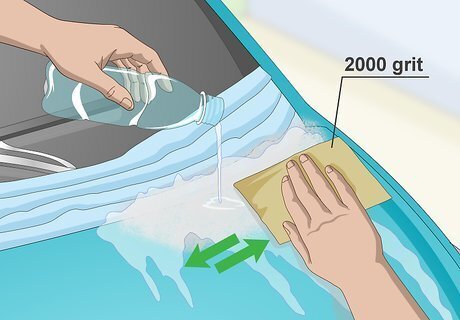
Wet-sand the primer with 2,000 grit sandpaper for best results. If the rust spot is in an easy-to-see place like the hood or trunk lid, you may want to go the extra mile to ensure an even, glossy finish. Pour water on the primer while sanding it with the 2,000 grit sandpaper to help create a very smooth finish. The water helps keep the paint cool and lubricated while you sand to prevent burning or glazing it. Make sure the entire area is clean and dry before moving on to the next step.
Painting the Metal

Spray on the base coat. Just like with the primer, you’ll want to hold the can (or gun) about 12 inches (30 cm) away from the metal as you spray. Spray from left to right in horizontal rows and make the rows overlap by about 50% if you need more than one to cover the area. Keep the can moving as you paint, otherwise too much could collect and result in dripping. Do not wet-sand a base coat of paint.

Wait at least 60 minutes for the base coat to dry. The last step will be applying a layer of clear coat to the paint, but before you can do that, the base coat needs to be completely dry. While it may take days for it to “cure” enough to be washed, most automotive paint is dry enough to be worked with in about an hour. If it’s especially humid where you are, wait 90 minutes to be safe.
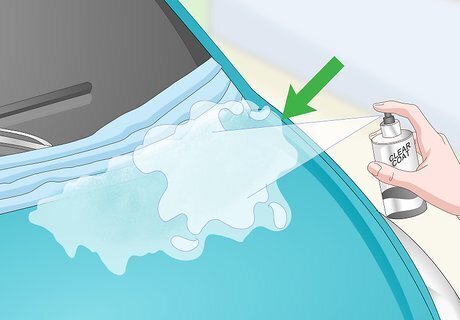
Add a layer of clear coat. Clear coat is another automotive paint that you can get in spray cans. It adds a layer of protection over the colored base coat and gives the paint a glossy shine. Spray it on just as you did the primer and base coat. Apply the clear coat in smooth, even rows just like the other paint. You can purchase clear coat from any auto parts store. Read the instructions on your specific clear coat to know how long it takes to dry.
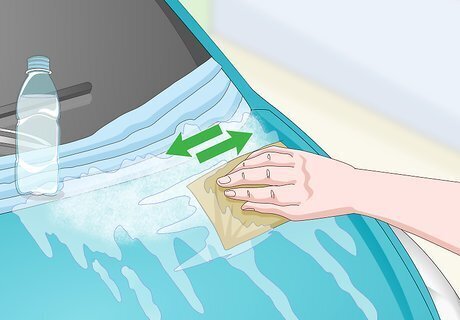
Wet-sand the clear coat once it’s dry if you want an excellent finish. The paint should already look pretty good, but you can make it look even better by sanding it with 2,000 grit sandpaper and water to remove any small blemishes and achieve a good shine. Keep pouring water over the paint as you sand it back and forth until it looks perfectly flat and even. In many areas, you can skip wet-sanding the clear coat and still have an excellent looking paint finish. Hoods, door panels, and trunk lids are some places you may want to wet-sand because paint issues will stand out on large, flat surfaces.
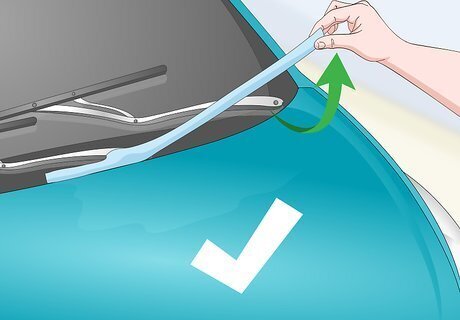
Remove the painter's tape. Pull all tape and any plastic you used to cover parts of the vehicle away and admire your finished product. However, don’t try to wash or wax your new paint for at least a week so it can cure thoroughly. The new paint may be slightly brighter than the old because of sun fading, but the two colors should be nearly indistinguishable. If you notice any issues with the paint, repeat the wet-sanding process to smooth it out.
















Comments
0 comment